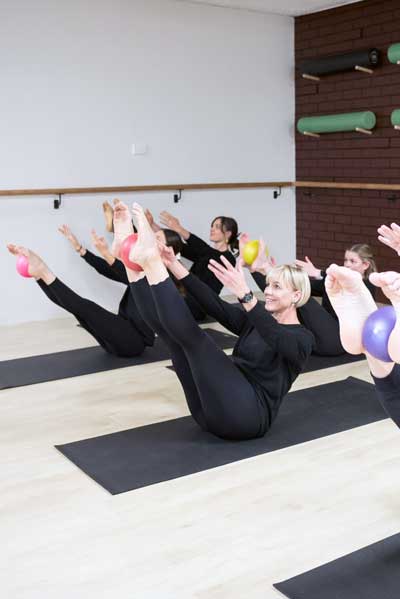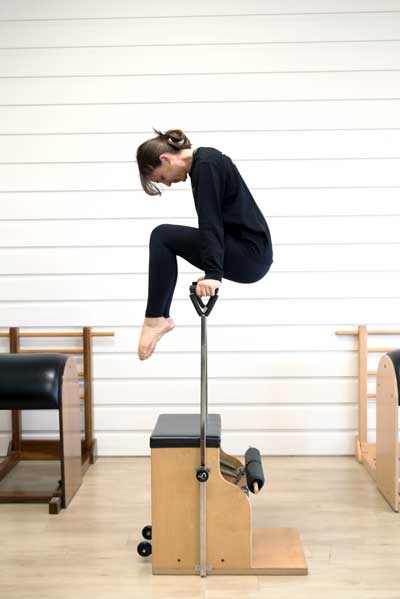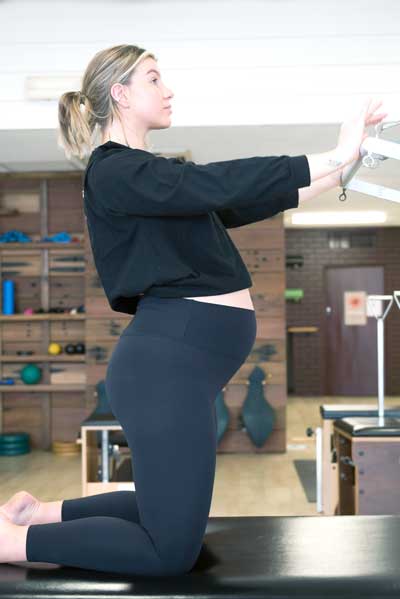What is Pilates?
The Pilates Method was developed in the 1920’s by the legendary physical trainer, Joseph H. Pilates. The Pilates Method was called Contrology and designed to create “WHOLE BODY HEALTH”.
Pilates works from the inside out and assists the body to cognitively register movement better to improve sports performance, decrease injury and rehabilitate from injury. Pilates Changes lives!
You can do Pilates. There is no person that can not partake in this amazing body work. From Ballet dancers and footballers, office workers and builders, Farmers and Doctors, injured or elderly; you can reap the benefits of the Pilates Method.
Pilates is based on the principles of movement and original exercise format both mat and equipment from Joseph. The equipment is based around a spring system that enables the body to work with gravity and in a continuous work effort.
Training the body both concentrically and eccentrically enable the weaker muscles to become more aware of their role so the more dominant muscles settle into a better pattern of efficient movement.
Pilates teaches the body symmetry and “positive movement experiences”. (Polestar Pilates motto).
What is an initial assessment?
An initial assessment is a requirement for you to partake in the studio classes. In the initial assessment your online fitness screening will be discussed by your highly qualified practitioner. The practitioner will assess your body in a dynamic formula. This will mean we will be addressing your injuries and goals and current postural components whilst moving. We ensure we consider all aspects of movement quality and functionality to ensure you gain maximum benefit from your Pilates sessions with us. Please wear appropriate workout gear and bring a bottle for water and socks. Shoes are not required.
What are Reformer Classes?
Reformer Classes are a group class and offer a more fitness specific class or we also offer specialised classes. The reformer class is a high energy non stop workout that we offer Beginner to Intermediate/Advanced workouts. All people wanting to do the Reformer classes must book in for either an initial consultation or our fundamentals class prior to booking a reformer class.
What is Studio Pilates?
Studio Pilates is based on the original Pilates Method from Joseph Pilates. In Studio Pilates you will work on all the equipment that is based on a spring system to guide and support your body and or challenge accordingly. In the NRP studio we have the Trapeze Table/Cadilac; Studio/Rehab Reformers and Floor reformers; Wunda Chairs and exo Chairs. Barrels and spine corrector, wall units and small apparatus. Studio classes can be done one on one and in small groups of 4-5. Studio classes are very specialised and individualised and appropriate from a rehab perspective to sports specific or for you wanting to have more attention on your body specifics.
What is the best way to get started in the Pilates method?
There are many ways you can get started. You can either join a class in your local area, book private lessons, or you may purchase our video to practice Pilates in the privacy of your own home. My recommendation is that you always begin with an initial assessment. This will enable you to discuss your history, objectives and goals and your instructor can then advise you on the most suitable session types for you moving forward.
How do I find an instructor or studio in my local area?
Please visit our join a class page to view locations and timetables. Remember you can always book a private lesson or organise a group of friends to join you in private sessions.
What are the Mat and Barre Classes?
Pilates Mat classes are based on the original Pilates mat exercises. We offer multi level classes meaning all classes give options for the less experienced. This is an open chain class adding the challenges of working with your body and gravity and not the spring system. We also use small props in these classes. The Barre classes is bringing the Pilates Philosophy and some of the Pilates movements into a challenging workout using the dance/ballet barre. The instructors that teach this tend to come from a dance background and it has a dance focus for muscular strength and workout.
What kind of benefits can I expect from practicing Pilates?
The low-impact technique is designed to improve posture and strengthen and lengthen muscles without adding bulk. The emphasis on breathing leaves clients feeling revitalized, rather than exhausted.
Why should I practice the Pilates method?
The Pilates method of exercise offers a non-stress approach to better posture and stronger, leaner muscles. It compliments aerobic exercises and can be used to help you recover after injury or simply to maintain good health and fitness.
What should I wear to a Pilates class?
Comfortable close-fitting clothes are best, because your instructor will want to make sure your body is moving with precision. No footwear is required. We recommend that you bring your own towel and exercise mat, as well as a bottle of water.
How often a week should I practice the Pilates Method?
For optimal effectiveness, it is recommended to train two to three times per week depending on your goals and level of fitness, especially if not participating in any other forms of exercise.
Can I lose weight with Pilates?
It is suggested that prospective clients undertake nutritional advice from a qualified practitioner prior to commencing Pilates. At its advanced level, Pilates does provide an aerobic/cardiovascular workout to help lose weight.
Can I cross-train with Pilates?
Absolutely! Pilates is ideal for cross-training purposes, as it will help create a better understanding of posture and how this relates to all forms of exercise. In addition, it will help to correct postural faults that can develop through repetitive forms of exercise.
Can I use Pilates for general fitness training?
Yes, because when Pilates is practiced on a regular basis, it encompasses all aspects of fitness, such as strength, flexibility, coordination, cardiovascular, motor skills and relaxation.
Is it safe to practice Pilates when pregnant?
It is recommended that you consult your doctor before embarking on any exercise program. Prospective clients should seek a Pilates instructor with ante natal /post natal qualifications. Open communication and feedback is extremely important between every pregnant client and her instructo
Does the Pilates fitness program help to reduce the hips and thighs?
Definitely! Designed to work the body as a whole you will not only see benefits in the hips and thighs but also in the rest of the body.
I am 50 years of age. Do you think the Pilates program will be too strenuous for me?
Absolutely not! Pilates caters for everyone from beginners to advanced and is suitable for all age groups. As with any exercise program, start on the beginner level, progressing slowly to more advanced levels. Listen to your body. It won’t happen overnight, but results will happen.
How different is Pilates from Yoga?
Although similar to Yoga exercise, Pilates requires you to set a posture and then challenge the torso by moving the limbs, whereas yoga will move from one static posture to another with no repetitions.
Does Pilates concentrate on breathing?
All Pilates exercises are taught with a breath sequence, but it isn’t the main emphasis of the technique.
Does Pilates help you become more flexible?
Yes! Pilates will strengthen and stretch your body at the same time, slowly building-up a range of movement as you become more advanced.
What prerequisites do I need to become a Pilates instructor?
Prerequisites for Mat Level 1 certification are a current first aid certificate, anatomy background through either college or university or Fitness Leader and it is highly recommended that you have a minimum of 100 hours of personal participation in Pilates prior to course commencement date to assist you in passing the practical assessment.
We recommend Polestar Pilates Australia, Pilates International and APMA training. Kimberley Garlick is an Educator for Polestar Pilates.


